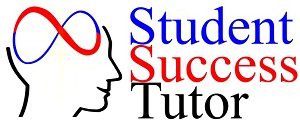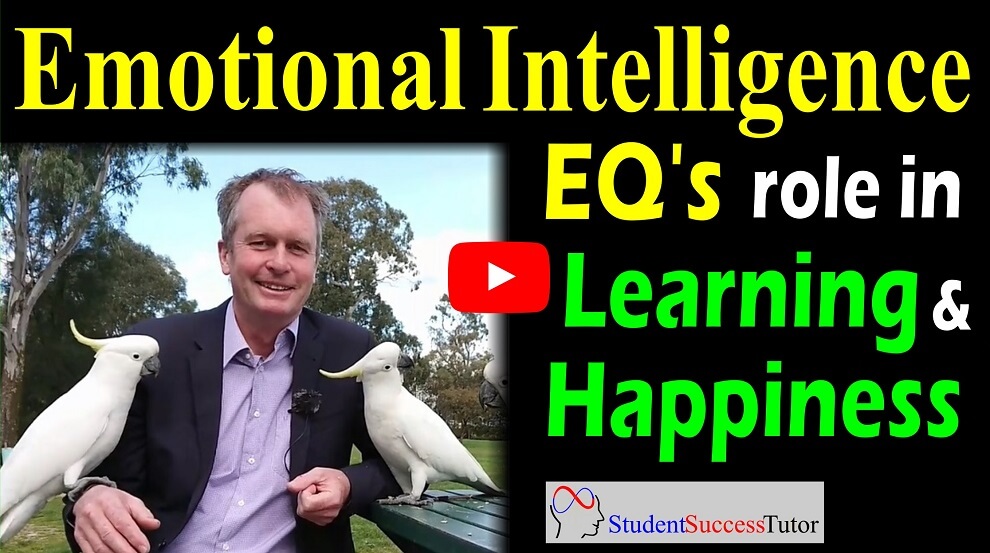Emotional Intelligence (EQ)
The KEY to Enjoyable Learning & Life Happiness
What is emotional intelligence?
Emotions versus Feelings
What's the difference?
Emotions in this website are defined as broadly as fear, anger (including frustration), sadness, grief, guilt, anxiety, and excitement. These are the core emotions. There are many other types of emotions but generally they are close relatives or variations of these six. These are then felt in different degrees with different flavors and therefore have different names. To complicate matters some emotions are a cocktail of these six core emotions.
Technically excitement could be classified as fear. The reason excitement is an emotion is simple: excitement is adrenaline based. Adrenaline is a fear fight-flight response. This is discussed at the bottom of the page.
Emotions are completely different from what is defined in these pages as feelings. Feelings include peace, awareness, spaciousness, stillness, calmness, joy, happiness, openness, connection, and love. Feelings are your natural state and as you become more conscious and learn to live in the Learning State these will be much more consistent in your life.
You learn to be aware of these undercurrent feelings as emotions rise and fall. Because feelings are the real you then they are actually always there--the only thing stopping it is your lack of awareness feeling them. The prime directives of the unconscious mind all aim to the final goal of these positive feelings being the default.
Emotional intelligence & State Awareness
Traffic Lights for indicating your Emotions
The State Awareness traffic lights can be used for gauging emotions and feelings. Practicing State Awareness provides sensory feedback of the mind, body, and emotional status. As with any skill the more it is practiced the more you understand the nuances. Your neurology learns to be more precise at providing feedback information.
As with any skill the more it is practiced the more you understand the nuances. Your neurology learns to be more precise at providing feedback information.
In terms of emotions (not feelings), strong ones would tend to indicate a red emotional traffic light status. A mild emotion would tend to be yellow status. Green is a slight emotional disturbance.
If you are good at State Awareness and holding the Learning State it means you are able to hold a red emotional traffic light and be fully functional. In March 2019 Jacinda Ardern, the New Zealand Prime Minister, demonstrated very high emotional intelligence as she handled the mass shooting tragedy that took place in Christchurch. In speaking to Cashmere High school, she said, “And one of the messages that I want to share to our young people in particular is it's ok to grieve. It is ok to ask for help, even if you weren't directly affected.” This was my high school as a student. I even taught study skills there after graduating with my Masters Degree in accelerated learning.
High EQ people tend to be very likable. If they have a problem with someone they will either not let it bother them (because it doesn't) or they will discuss it in a helpful manner with the concerned individual. When discussing it with the individual /group they will do so without venting their emotions. They will tend to treat this situation as a problem solving activity. Blame will be absent it is about finding the solution.
Low emotional intelligence is indicated by automatic negative reactions with strong emotions to a small event. For example, someone screaming and yelling about a door not being closed. Being violent with rage and anger, unless life threatening, is a clear sign of low emotional intelligence. Medium emotional intelligence means some things can be handled easily and some things cannot.
Your capacity at holding State Awareness (i.e., the traffic light exercise) and your ability to hold the Learning State will give a clear indication of how high your emotional intelligence is.
For a happier life
grow your emotional intelligence
As a student how are your emotions related to your study? As you practice changing your state into the Learning State it means you can be resourceful when no-fun emotions are running. Often with study, it is a matter of making a start even though you may feel resistant (yellow traffic light), but once you are making progress you will feel better as you are helping yourself succeed.
How do these study skills actually help you to be a better and happier person? As you learn to use your State Awareness traffic lights and the Learning State it also means you can choose to change how you feel. Thus you become more stable and happy, and people will find you much better to get along with.
Purpose of emotions
Emotions have a special purpose most ignore
Feelings feel good, or at least peaceful or neutral. Emotions do not feel nice, with the exception of excitement. We naturally want them gone. Emotions often are the fuel and trigger for bad and destructive behaviors. The unconscious mind, the inner you, who creates and manages emotions runs under the prime directives to feel good and also to be a nice person (a moral being prime directive 11).
Question: So what is the purpose of these things called emotions that are under the management of the unconscious mind?
Answer: Emotions send the message that awareness is required for something to be resolved or acted upon.
The intention of every emotion is to help restore the prime directive No1 of the unconscious: to firstly be safe. Then to feel good (not to be driven by bad emotions) or at least be at peace and then be lazy. Minimal energy expenditure, to be lazy, is prime directive 20. Effectively the unconscious mind desires to be in the Learning State (the Whispering State or Presence). Thus the natural pull is to be at ease, peaceful, and feeling happy.
Observe a baby in a psychologically healthy family environment that is 3 to 12 months old. How do they behave? They are called a bundle of joy for a reason. This is the natural state of the unconscious until it is corrupted by trauma and bad habits. This is what the unconscious mind seeks for the person. The prime directives ensure that this is the easy path.
Babies and children soak up the behavioral norms of the family and society. Absorbing and adjusting to the environment continues throughout life. Zero to seven years are the golden years of most programming, where the conscious mind and identity form alongside the brain, neurology and body. Then eight to fourteen is the second most influential. The third stage is that of the teenager, 14 to 21. This is where the teenager comes out and tries to be me, much to the resistance of parents and society. Out comes the ego and the shadow to test their validity and identity as an individual. In Western cultures, we celebrate the 21st birthday as a big event of maturity for this reason. The symbol of the lock and key is often associated with 21st birthdays for this reason.
As age progresses, the change is slower unless traumatic events create significant shifts. Traumatic events activate the core No1 prime directive of survival, then suppression/repression is triggered and the emotional state is set to the extreme red traffic light. Depending on the depth of the trauma it can result in a significant psychological condition. An example would be post traumatic stress disorder (PTSD) in soldiers and abuse survivors.
The life skill set here at Student Success Tutor is designed primarily for the Learning State (pillar No1) to maximize learning and academic success. The structural aspects are all within the 9 pillar framework. The brilliance of this method is it offers a simple method to restore correct function of the unconscious mind (pillar No5). If the student, parent or teacher decides they want this for themselves they then have the tools to make significant shifts to having a life based in at least peace, if not joy and happiness. This website hopes to provide the evidence this is possible by my story and experiences.
This method cannot be forced onto another, it is a conscious action within the neurology of the individual (pillar No4 Law Zero). This is free will, of conscious volitional attention (State Awareness). Nobody can ever take the choice of attention placement away from a person. Removing conscious volition is impossible unless the brain is physically damaged, under extreme trauma or under constant duress, drugs or societal unconscious persuasion.
Restoring the unconscious mind to its natural default is the metaphorical return to innocence. The Learning State is the restoration of the default setting. This method taught here is free from bias, control and can be applied to any social or religious context. Being a good person is innate, all societies want good people. I'm sure you'd prefer good people around you over those that are not nice, immoral, or doing things that violate other people's personal boundaries, eh?
The message of the emotions
Each type of emotion has a specific type of message. If State Awareness is being practiced and the emotion can be defined it will indicate how the issue was caused and what may be done to resolve it. Once the issue is identified, the conscious mind can then have a chat with the unconscious mind. If you talk to your unconscious like I do to the birds it is more likely to listen and resolve the issue. The emotion will then fade out. The next time in life the same event happens the emotion will be much less. Thus if you have higher emotional intelligence a conscious response can be given rather than a knee-jerk reaction.
Summary of the messages types by the emotion type
Anger: The message that something needs to change. This is often because a need or a want has not been fulfilled. Hence the explosive desire to make something happen when anger is being felt. With our safe modern life, the need for the explosiveness of anger isn't typically needed. We won't face a wild bear or lion strolling into our home. At the unconscious level this isn't recognized, as the unconscious is a 5 year old child. The key with anger is to recognize what is not being met. Being bullied, which is a threat to safety, is a valid reason for anger. Action needs to be taken to stop receiving this sort of treatment.
On the other hand being given a banana milkshake when chocolate was ordered is a less valid reason for anger. Though you can choose to be State Aware and use the energy and nicely request a chocolate replacement.
Sadness: A message that something is not being received or something has just been lost. It may be the loss of something or someone or a sense of disappointment. Understanding the loss can help, but feeling sadness rather than avoiding it is the best way to move through it. Allowing tears to flow when they want to is often the best method to let the loss be released. Allowing the sadness to be felt in the Learning State (full neurology activated) is extremely effective with sadness.
Fear: This is the survival instinct speaking. The number one prime directive is Safety (preserving the body)! It is the red alert function to react and run. The fear may also turn into the stay and fight as it is the flip side of the fight-flight instinct that all animals have.
Anxiety: This is future fear. Anxiety's message is clear: preparation is required so get on with it and perform the needed tasks. Past traumas can also set up expectations of future failure, which will trigger anxiety. Anxiety's message is very healthy unless it is trauma based from prior experiences.
Guilt: As mentioned prior the unconscious mind is a highly moral being. To be a good person is natural, it's a prime directive. Guilt is a message I'm not being good. With repeated practice guilt is suppressed and will not register and it becomes easy to perform wrongful acts. Guilt is a healthy sign that the unconscious prime directive to be a moral being has not been corrupted. If guilt is being felt then an apology or corrective action may be required.
Trauma and external conditioning from authority figures can also install a habitual guilt response in the unconscious mind of the individual or groups (and countries). If the State Awareness exercise is being used, and the Learning State activated, then the conscious mind can be used to examine this response and undo the habit. A psychologically healthy person can easily decide what is a rightful action without the need for doctrine. The correct action is always related to inherent feelings of love, peace, and caring for a mutually positive outcome. Win/win is the simple answer.
Excitement: Excitement is classified here as an emotion, not a feeling. Excitement is fear inverted as it generates the production of adrenaline which is the fear chemical produced by the body. Its message is wanting an outcome now but fear is also present as it is not yet certain. . . so let's do this and hope the outcome is good. That is why extreme sports are exciting, as they have a real possibility of injury or death. Hence it is fear which is felt as positive excitement.
Interpreting emotions
Emotions feel yuck - but they have a special message to tell you
Emotions are only the messenger. They are not the message. Few people understand this point. The tricky bit is to understand what is the message. For example, yelling and screaming with anger about a door not being closed could be accumulated frustration over a door being left open many times, or it’s unresolved issues about not being listened to. There are many ways to solve this problem. The anger is a tool to hopefully help it be heard how important it is that the need or want for the door to be shut occurs. It may also be a sign that you, the angry person, need to deal with something so it no longer bothers you.
Because humans are so complex there may be other past events stored in the unconscious for resolution. The prime directives of the unconscious mind ensure the presentation of unresolved emotions where possible so they are processed and let go. The colloquial term for these stored unresolved events is emotional baggage. That may add extra emotional volume to the current event by the unconscious mind so it is unburdened.
With time and practice of State Awareness and using the Learning State one becomes very good at noticing when the green traffic light is left for yellow. Sensitivity to the yellow traffic light develops with practice. This then helps faster resolution consciously to bring back the state of equilibrium. It is far easier to activate State Awareness and the Learning State in the yellow traffic light than the red.
Then the neurology can be trained to be in the Learning State and hold emotions when in the yellow state, and later the red traffic light. For example, it is easier to learn and hold the Learning State with mild frustration (yellow) than it is with anger (red). As frustration is a milder version of anger mastering these less intense emotions will happen before anger can be held consciously and resourcefully in the Learning State. With dedicated practice one will eventually hold the Learning State (full neurological functioning and conscious choice) in extreme circumstances and when strong emotions are happening. The emergency response page covers this topic.
Maintaining or entering the state of full neurological function and conscious choice (defined in this website as the Learning State) means the emotions can be held and not shared with the people involved. Or the person may well express the emotions depending on the situation. It may be ok to yell at someone in the family, but it may not work yelling at an employer as it may result in unemployment.
With these life skills taught here, the emotional events can be addressed and resolved with the use of the Learning State. This can be covered in coaching to assist in growing this skill and ability. Clearing emotional stresses are important as it allows a deeper Learning State for study, review and performance in assessments.
To master the skill of finding the emotion's message takes practice. Often just being aware and using a Learning State can resolve it. The unconscious will often provide the "ah-ha" intuition as to the reason, and why is that? The Learning State is the alpha brain wave state where intuition functions as all the neurology is accessible for integration and processing. By definition the Learning State is the optimal state.
The only question is how much is the State Awareness and Learning State entry practiced? This is why ongoing coaching will develop this most profound life enhancing state for learning, life success, and default happiness.
Book a session now. Let's discuss an action plan
Individual online tutoring is limited to 12 students a week.
Book here. World-wide online.
Why is excitement an emotion?
Quiz the people around you and ask, "is excitement an emotion or a feeling?" What is your view?
As a point of interest, here is why excitement is classified as an emotion and not a feeling on this website.
The reasoning given here may be unique, but this is my experience based on the mastery of the Learning State. This includes my research into learning, neuroscience and my experience with monitoring the prime directives of the unconscious mind since 1995 (when I became totally focused on mastering NLP [Neuro Linguistic Programming]). Excitement generates adrenaline. Adrenaline is the core hormone used by the body to generate the fight-flight survival instinct in the limbic system and reptilian brain. Thus excitement is fear based and initiates the flight response.
Adrenaline is the core hormone used by the body to generate the fight-flight survival instinct in the limbic system and reptilian brain. Thus excitement is fear based and initiates the flight response.
This is demonstrated by most animals, even the most venomous on the planet. Even the extremely deadly Australian snakes will run first, not fight and bite. Thankfully this is the case as I have a habit of running into them, even in Melbourne's metropolitan suburbs. I have yet to witness a deadly snake being aggressive towards me. I instantly freeze and go into a deeper Learning State as a learned response. Then I evaluate the animal and choose a response.
The extra-calm and associated body language helps these beautiful animals remain calm and feeling unthreatened until they decide to leave. To me, this picture I took shows a truly beautiful, very deadly, copperhead snake that was next to a walking track at a popular spot on the famous Great Ocean Road. My body does not release adrenaline in these instances. Normally adrenaline is initially used for quick reaction times in the muscles. From fear it can switch from flight to fight and provide extra muscle strength for the battle to ensure survival.
If the Learning State is truly mastered it becomes a default habit. After a few years of the Learning State settling to the default position excitement becomes rare. There is no need for fear as most situations are met with the full resources the unconscious mind has to offer. When excitement is experienced, the effect on the body and energy levels is noticeable compared to the peaceful place of the Learning State. It does actually feel unpleasant. Strong excitement feels jarring. There is a noticeable hangover in the body after strong excitement. It is still enjoyable when it happens, but it becomes less common. This helps explain why I managed a full day's work after being hit by a car, and spent the next day in bed feeling exhausted and very sore. My Learning State abilities kept me in full function with a clear mind, even though my body was loaded with adrenaline after potentially facing severe harm or death.
The prime directives of the unconscious mind point to this. Adrenaline production stresses the body, the endocrine system especially. It makes the muscles go on high alert, which is stressful and burns energy. This violates a number of the prime directives of the unconscious mind, its rule book. Our unconscious is supremely wise when it is functioning correctly. It will not waste energy--it likes to be lazy and feeling good. The Learning State becomes a very happy and relaxed place to live from. As this habit deepens it entrenches as the default behavior state in more and more difficult instances. Recovery back to the green awareness state happens faster.
Book a session now. Let's discuss an action plan
Individual online tutoring is limited to 12 students a week.
Book here. World-wide online.

